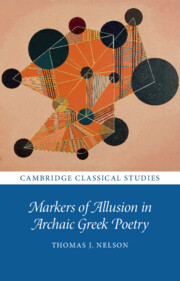76 results
The road to recovery: conservation management for the Critically Endangered Bali myna shows signs of success
-
- Journal:
- Oryx , First View
- Published online by Cambridge University Press:
- 20 November 2023, pp. 1-11
-
- Article
-
- You have access
- Open access
- HTML
- Export citation
Dedication
-
- Book:
- Markers of Allusion in Archaic Greek Poetry
- Published online:
- 11 May 2023
- Print publication:
- 25 May 2023, pp v-vi
-
- Chapter
-
- You have access
- Open access
- HTML
- Export citation
Copyright page
-
- Book:
- Markers of Allusion in Archaic Greek Poetry
- Published online:
- 11 May 2023
- Print publication:
- 25 May 2023, pp iv-iv
-
- Chapter
-
- You have access
- Open access
- HTML
- Export citation
Chapter IV - Time For Allusion
-
- Book:
- Markers of Allusion in Archaic Greek Poetry
- Published online:
- 11 May 2023
- Print publication:
- 25 May 2023, pp 244-327
-
- Chapter
-
- You have access
- Open access
- HTML
- Export citation
Contents
-
- Book:
- Markers of Allusion in Archaic Greek Poetry
- Published online:
- 11 May 2023
- Print publication:
- 25 May 2023, pp vii-viii
-
- Chapter
-
- You have access
- Open access
- HTML
- Export citation
Chapter II - The Pre-Alexandrian Footnote
-
- Book:
- Markers of Allusion in Archaic Greek Poetry
- Published online:
- 11 May 2023
- Print publication:
- 25 May 2023, pp 73-175
-
- Chapter
-
- You have access
- Open access
- HTML
- Export citation
Chapter III - Poetic Memory
-
- Book:
- Markers of Allusion in Archaic Greek Poetry
- Published online:
- 11 May 2023
- Print publication:
- 25 May 2023, pp 176-243
-
- Chapter
-
- You have access
- Open access
- HTML
- Export citation
Chapter I - Introduction
-
- Book:
- Markers of Allusion in Archaic Greek Poetry
- Published online:
- 11 May 2023
- Print publication:
- 25 May 2023, pp 1-72
-
- Chapter
-
- You have access
- Open access
- HTML
- Export citation
Bibliography
-
- Book:
- Markers of Allusion in Archaic Greek Poetry
- Published online:
- 11 May 2023
- Print publication:
- 25 May 2023, pp 332-416
-
- Chapter
-
- You have access
- Open access
- HTML
- Export citation
Acknowledgements
-
- Book:
- Markers of Allusion in Archaic Greek Poetry
- Published online:
- 11 May 2023
- Print publication:
- 25 May 2023, pp ix-xi
-
- Chapter
-
- You have access
- Open access
- HTML
- Export citation
Conventions and Abbreviations
-
- Book:
- Markers of Allusion in Archaic Greek Poetry
- Published online:
- 11 May 2023
- Print publication:
- 25 May 2023, pp xii-xvi
-
- Chapter
-
- You have access
- Open access
- HTML
- Export citation
Chapter V - Epilogue
-
- Book:
- Markers of Allusion in Archaic Greek Poetry
- Published online:
- 11 May 2023
- Print publication:
- 25 May 2023, pp 328-331
-
- Chapter
-
- You have access
- Open access
- HTML
- Export citation
General Index
-
- Book:
- Markers of Allusion in Archaic Greek Poetry
- Published online:
- 11 May 2023
- Print publication:
- 25 May 2023, pp 435-442
-
- Chapter
-
- You have access
- Open access
- HTML
- Export citation
Index Locorum
-
- Book:
- Markers of Allusion in Archaic Greek Poetry
- Published online:
- 11 May 2023
- Print publication:
- 25 May 2023, pp 417-431
-
- Chapter
-
- You have access
- Open access
- HTML
- Export citation
Index of Indices
-
- Book:
- Markers of Allusion in Archaic Greek Poetry
- Published online:
- 11 May 2023
- Print publication:
- 25 May 2023, pp 432-434
-
- Chapter
-
- You have access
- Open access
- HTML
- Export citation

Markers of Allusion in Archaic Greek Poetry
-
- Published online:
- 11 May 2023
- Print publication:
- 25 May 2023
-
- Book
-
- You have access
- Open access
- Export citation
The Hierarchical Taxonomy of Psychopathology (HiTOP) in psychiatric practice and research
-
- Journal:
- Psychological Medicine / Volume 52 / Issue 9 / July 2022
- Published online by Cambridge University Press:
- 02 June 2022, pp. 1666-1678
-
- Article
- Export citation
Characterisation of age and polarity at onset in bipolar disorder
-
- Journal:
- The British Journal of Psychiatry / Volume 219 / Issue 6 / December 2021
- Published online by Cambridge University Press:
- 25 August 2021, pp. 659-669
- Print publication:
- December 2021
-
- Article
-
- You have access
- Open access
- HTML
- Export citation
SELEUCID LITERATURE - (M.S.) Visscher Beyond Alexandria. Literature and Empire in the Seleucid World. Pp. xiv + 256, maps. New York: Oxford University Press, 2020. Cased, £55, US$85. ISBN: 978-0-19-005908-8.
-
- Journal:
- The Classical Review / Volume 71 / Issue 2 / October 2021
- Published online by Cambridge University Press:
- 12 May 2021, pp. 336-338
- Print publication:
- October 2021
-
- Article
- Export citation
TRAGIC NOISE AND RHETORICAL FRIGIDITY IN LYCOPHRON'S ALEXANDRA
-
- Journal:
- The Classical Quarterly / Volume 71 / Issue 1 / May 2021
- Published online by Cambridge University Press:
- 18 May 2021, pp. 200-215
- Print publication:
- May 2021
-
- Article
-
- You have access
- Open access
- HTML
- Export citation



